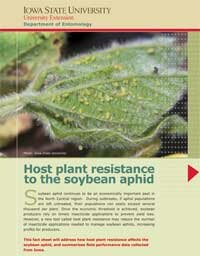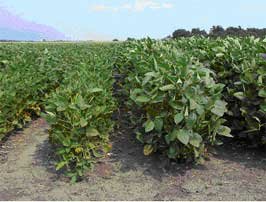
-
Diseases
- Asian Rust
- Anthracnose
- Bacterial Blight
- Bacterial Pustule
- Bean Pod Mottle Virus
- Brown Stem Rot
- Cercospora Leaf Blight
- Charcoal Rot
- Downy Mildew
- Frogeye Leaf Spot
- Green Stem Syndrome
- Iron Deficiency Chlorosis
- Phytophthora Root & Stem Rot
- Powdery Mildew
- Rhizoctonia
- Seedling Diseases
- Septoria (Brown Spot)
- SCN (Soybean Cyst Nematode)
- Soybean Mosaic Virus
- Stem Canker
- Sudden Death Syndrome
- Viruses
- White Mold
- Pests
- Biological Control
- Agronomics
- Diagnostic Tools
- About Us
- Library
Research Initiatives 2011
 |
| Ed Cagney, President, NCSRP |
At the annual meeting in March, the NCSRP Board approved the following research projects for funding in fiscal year 2011. Several of the projects are being jointly funded by the United Soybean Board and state checkoff boards.
Soybean Disease Studies
Sentinel plots to monitor the spread of soybean rust in the U.S. soybean production regions
The soybean rust sentinel plot monitoring and early warning network, established in 2005, will be continued. Sentinel plots in Tier 1 states (AL, FL, GA, LA, MS and TX) will be developed, and foliar diseases monitored during the growing season. All observations will be entered into the USDA/ARS ipmPIPE soybean rust web site for public viewing.
 |
| North Florida Research and Education Center in Qunicy, Florida is the headquarters of active research on soybean rust-resistant soybean varieties, fungicide trials, and soybean rust epidemiology. |
Population dynamics and epidemiology of Asian soybean rust in North American soybean production systems
This is a continuing effort to develop management strategies for the control of Asian soybean rust in North America. The major research center for soybean rust field research is located at the North Florida Research and Education Center in Quincy, FL. While Florida is not a major soybean producing state, it has thousands of acres of kudzu, an alternative host of the pathogen, and high soybean rust disease pressure.
Specific objectives are to
- Develop field scale disease models based on temperature, relative humidity and leaf wetness and link these factors to overwintering inoculum sources on kudzu
- Continue a multistate collaboration with scientists needing to work on soybean rust under high disease pressure conditions;
- Continue to assist in the development of cultivars with resistance to soybean rust; and
- Offer an annual hands-on, field-oriented workshop on rust identification and management.
 |
| A soybean variety susceptible to sudden death syndrome bordered by resistant varieties. Photo credit: University of Wisconsin |
The Sudden Death Syndrome Research Alliance
Sudden death syndrome (SDS) is now widespread across most soybean producing areas in the United States, and is considered to be one of the major soybean diseases.
The development of soybean varieties resistant to SDS is a major focus of this program. Resistance genes present in the 11,000 accessions of the UDSA Soybean Germplasm Collection and advanced soybean breeding lines will be identifed. Field tests will be conduct to verify the SDS resistance of experimental lines and the effect of SDS-resistance QTLs (quantitative trait loci are stretches of DNA containing the genes that underlie a quantitative trait). Genetic markers to aid in efficient selection will be developed by mapping the SDS resistance QTLs to small genetic intervals. Partial resistance in early maturity lines will also be studied.
The second research focus is the factors that affect the survival, spread and infection of soybean by the SDS pathogen, Fusarium viguliforme, in particular the interaction with other microorganisms on the plant root.
The group will continue to develop educational materials to improve management and awareness of SDS.
 |
| Soybean field showing symptoms of iron deficiency chlorosis. Photo credit: R.J. Goos, North Dakota State University |
Iron deficient chlorosis: Getting to the root of the problem
Iron deficiency chlorosis (IDC) is consistently rated as one of the most serious production problems affecting soybean yields in the upper Midwest. Seedlings affected by IDC consistently yield less. From a physiological perspective, iron metabolism is a complex process in plants, which involves modifying the soil chemistry, converting iron in a form that the roots uptake, transferring the iron into the root, and transporting the iron to the shoots.
This research program will consider the many components of the physiological process and determine which are most relevant for IDC tolerance. Potential resistance genes will be identified and isolated and markers developed for these genes that will aid the soybean breeder in developing IDC-tolerant and resistant varieties.
Screening for genetic resistance against soybean viruses
Previous research has found that the control of the bean pod mottle virus (BPMV) could not be achieved through management of the virus vector, the bean leaf beetle. Therefore, the most practical and reliable method for disease control is disease resistance. The goal of this project is to identify resistant BPMV soybean lines that can be used by soybean breeders.
The research will use a novel seed-based assay method developed by John Hill (ISU) and Craig Grau (UW) that identifies BPMV tolerance by measuring the amount of virus in a seed. The method involves an engineered BPMV isolate that contains a gene for herbicide resistance. When soybean plants are inoculated with the engineered BPMV isolate, one can easily and rapidly assay for BPMV resistance. A similar antibody-based assay for detection and quantification of alfalfa mosaic virus (AMV) will be developed.
 |
| Soybean varieties differ in their response to white mold infection. |
Improved management of Sclerotinia stem rot in the North Central region
The goal of this project is to identify and understand the expression of resistance to Sclerotinia stem rot (SSR, white mold) that is of a high level and stable across many environments. A coordinated and collaborative research and breeding effort will examine recombinant inbred lines for complete resistance to Sclerotinia sclerotiorum using greenhouse assays and association mapping.
A second goal of this project is to develop effective educational materials on the risk and management of SSR in a given growing season.
Soybean Cyst Nematode Studies
 |
| Severe stunting and yellowing due to SCN infection is visible in this field. However, significant yield loss can occur from SCN feeding without causing above-ground symptoms. Photo credit: Greg Tylka, Iowa State University |
Improving management of soybean cyst nematode through Extension demonstration and outreach: Phase II
The project goal is to improve soybean cyst nematode (SCN) management in the North Central states. As part of this overall goal the team will establish on-farm plots in all states involved. The focus will be on large scale demonstrations that provide an information resource for Extension grower meetings and developing fact sheets.
The projects specific objectives are to:
- Improve management and awareness of SCN
- Produce educational materials that summarize results of the project that impact SCN management
- Provide a forum for state Extension specialists to coordinate research and Extension educational activities
Development of a high resolution genetic map for the soybean cyst nematode
The goal of this project is to complete the high-resolution genetic map for the soybean cyst nematode (SCN).
Whole genome sequence data were recently collected in a NCSRP-funded project, which allowed genetic analysis of SCN. The next step is to develop a high-resolution genetic map that organizes all the fragments of the SCN genome into linkage groups/chromosomes. This will allow the expressed genes and SNPs to be mapped to a particular region of the genome and permit genetic map-based cloning of key nematode genes required for controlling SCN.
Soybean Aphid Research
 |
| To date, at least four different genes have been isolated. The first gene to be identified, named Rag1, was found by USDA scientists and tested in 5 midwestern states in 2009. Commercial varieties will soon be on the market. |
Soybean aphid management in the North Central states
This is a coordinated regional soybean aphid research program on the management of the soybean aphid through classic biological control and host plant resistance, which is soon to be deployed commercially.
The project provides for a network of collaborating entomologists, plant breeders, and Extension specialists in twelve states to develop answers to complex issues facing soybean growers in managing the soybean aphid.
The project’s specific objectives are to:
- Study chemical control/resistant variety interactions. The specific studies involve developing appropriate thresholds for resistant varieties, establishing treatment thresholds for late R5 and R6 soybeans; modeling and sampling aphid populations; and field-screening promising soybean breeding lines;
- Study the interaction of genetically-resistant varieties and biocontrol agents. The researchers will establish how natural enemies affect aphid population doubling time on Rag1 resistant lines; and determine whether susceptible lines are used as refuges for predators;
- Expand biological control studies. These studies involve foreign exploration, host range testing, and release and follow-up monitoring of the predators;
- Study the mechanisms of plant resistance with specific attention to plant response to aphid feeding and functional plant genomics; and
- Develop and publish soybean aphid management guidelines for susceptible and aphid-resistant soybean lines.
Molecular dissection of soybean aphid biotypes and aphid resistant soybean genes for controlling soybean aphids
Soybean varieties have been developed that offer resistance to the soybean aphid, but soybean aphid populations (i.e. biotypes) have already been discovered that can overcome this resistance.
The goals for this proposal are to use an interdisciplinary approach of classical soybean breeding and modern molecular sequencing to:
- Characterize specific gene expression of aphid biotypes on resistant and susceptible soybean hosts;
•Identify the genetic basis for Rag2 gene; - Map quantitative trait loci (QTL) for partial resistance against soybean aphid; and
- Determine the distribution and frequency of soybean aphid biotypes, specifically those virulent to Rag1 and Rag2 genes, through detached leaf assays and molecular marker diagnostics.
Genetic and Biotechnology Studies
 |
| Thomas Baum, Steve Whitham and John Hill (ISU) use VIGS technology to identify soybean defense genes |
The use of VIGS technology to decrease yield-limiting stress in soybeans
The project’s goal is to understand the genetic pathways involved in resistance to biotic and aboitic stress. With this understanding, soybean germplasm can be developed with features that respond less to variation in growing conditions.
The VIGS technology uses bean pod mottle virus to carry pieces of soybean gene sequences into the plant to turn off (silence) requisite target genes. In this technology, a piece of a soybean gene is placed in the BPMV virus vector and inserted in the soybean genome. VIGS technology allows for rapid screening and assessing the function of the genes being tested.
Enhancing disease resistance in soybean through the tools of biotechnology
This program will evaluate transgenic approaches to understanding the molecular cues involved in plant/parasite interactions.
Specifically, field trials will be conducted in Ohio and Nebraska with transgenic soybean events identified with resistance towards three major viruses that infect soybean, BPMV, AMV and SMV. In addition, strategies for the expression of RNA interference molecules in soybean will be designed and tested for effectiveness in preventing aphid feeding.
Characterization of promoters from soybean pathogen-resistance genes
The goal of this project is to better understand how soybean responds to pathogen infection. The approach is to isolate and study the regulatory regions of pathogen defense-response genes.
After genes that are involved in the defense-response are identified, the promoter regions of those genes will be cloned and studied using a variety of different approaches. As promoters largely dictate the intensity and timing of gene expression, they should provide critical and precise information on responses of the soybean plant to pathogen infection processes.
 |
| SCN variety test |
Engineered resistance to soybean cyst nematode via induced gene silencing (RNAi)
Previous research has shown that turning off genes by a process known as RNA interference (RNAi) has tremendous potential as a new strategy to increase nematode resistance. This project will investigate the possibility of inserting target gene sequences into the nematodes to obtain durable genetic material lethal to SCN populations.
The researchers will engineer stable transgenic soybean plants with traits that can silence specific nematode genes, evaluate transgenic lines with SCN bioassays to confirm the effectiveness of the level of SCN resistance, and examine the durability of the transgenic traits on single and diverse populations of SCN.
Nested association mapping (NAM) of genes controlling soybean yield and other key traits
The goal of this research project is to map the chromosomal locations of genes that control soybean yield and other important agronomic traits in both domestic and exotic germplasm.
Germplasm lines will be genotyped using 1,536 molecular markers and evaluated for yield and other key agronomic traits in performance trials conducted by collaborating soybean breeders located in several Midwest states. The team will identify new germplasm that can increase yield, improve the efficiency of combining genes that are responsible for yield, and facilitate the development of higher yielding soybean varieties.
 |
Genomics to accelerate the annual rate of soybean genetic yield improvement
The objectives of this project will fulfill several priorities identified in the Soybean Genomic Research Strategic Plan developed by the soybean research community. These include:
- Resequencing key soybean cultivars to capture and leverage diversity in soybean germplasm;
- Developing comprehensive gene expression data for soybeans;
- Determining the role of epigenetics in soybean improvements.
This project will use state-of-the-art genomic tools to understand the chromosomal rearrangements and gene combinations that were responsible for soybean yield improvements over the past seventy years. This will involves genomic analyses of major ancestral land race varieties of soybeans and major historical commercial varieties that have achieved higher seed yield levels. Knowing the areas of the chromosome that have been arranged during past soybean breeding efforts will result in a better understanding of the genes/gene combinations responsible for soybean yield improvement.
 |
Technology Transfer
The goal of this project is to increase grower awareness of solutions for disease and insect problems by transferring knowledge gained from checkoff-funded activities to soybean producers through the electronic and print media. The project will continue to position PHI as an authoritative resource of plant health information.
The specific objectives of the project are:
- Provide science-based information to soybean producers that can be used to reduce soybean yield loss from disease and insects;
- Sponsor conferences and workshops that highlight soybean disease research topics;
- Develop educational materials that will help soybean growers better manage soybean diseases and pests; and
- Facilitate and coordinate research and information transfer between industry, university, media and Midwest soybean growers.

|
Explore soybean checkoff with the new Soybean Checkoff Research Database Search and explore the entire soybean checkoff research program on a new website funded by the United Soybean Board. Search for projects of interest by Key Word, by Researcher, or by Checkoff fund (including NCSRP). |
Your soybean checkoff. Delivering results.

